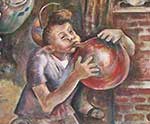Check out these unique destinations that reflect the genuine character of our region.

“Fish Fry in the Park” Mural
United States Post Office, 26 S. 3rd St., Geneva
In 1938, Geneva opened its new $65,000 post office. Four years later, this 17-by-9-foot, tempera-on-canvas mural was painted by Manuel Bromberg, a 24-year-old artist employed by the Works Progress Administration (WPA). It’s said he was inspired by seeing folks in the park fishing in the Fox River.
From 1935-1943, FDR’s Federal Arts Program, administered by the WPA, commissioned artists by the thousands to create murals, paintings and sculptures in public buildings across the nation. The idea was to expose the general public to more art and boost morale.
In Illinois, thousands of pieces were crafted by more than 750 artists, adorning public schools, hospitals, libraries and post offices with depictions of the “American Scene.”
In 2011, the Geneva mural was restored and reinstalled by the Chicago-based PARMA Conservation Ltd. Unfortunately, most WPA art wasn’t as well cared-for. Many pieces were lost when buildings were renovated or razed, especially murals painted directly onto the walls. Of the more than 1,000 painted in Illinois, it’s estimated that fewer than 250 remain.
Bromberg painted two other post office murals, one in Greybull, Wyo., and one in Tahlequah, Okla. During World War II, he served in the Army’s War Artists Unit, painting and sketching scenes of the war all through Europe, including the Normandy invasion. Bromberg was awarded the Legion of Merit for his wartime artistic achievements, and his work is featured in the 2000 PBS war artists documentary, They Drew Fire.
Visitors can see the restored mural during regular post office hours.

Egyptian Theatre
113 N. 2nd St., DeKalb, (815) 758-1215, egyptiantheatre.org
This 1929 art deco building pays homage to the Egyptian Pharaoh Ramses II, with a 20-foot-tall stained glass window over the marquee, flanked by two large pharaohs. It has 40-foot ceilings in the lobby, richly colored plaster walls and pillars entwined with serpents in the main theater.
The outside looks like the gate of a great temple, and the window has a sacred scarab. A sunburst tops the ticket window. The lobby has the original mosaic floor and eight decorated pillars, topped with gold falcon’s wings. The original double staircase leads to the mezzanine and balcony; a milky, lotus-patterned chandelier commissioned for the building hangs above the landing.
In the 1970s, citizens formed Preserve the Egyptian Theatre (P.E.T.), eventually restoring the stunning movie palace. It was added to the National Register of Historic Places in 1978. Today, the building hosts more than 100 events annually.
After more than 30 years, repairs are again needed, but the group is dedicated to the theatre’s preservation and working to raise the money needed.

Walkup Heritage Farm & Garden
5215 N. Walkup Road, Crystal Lake, (815) 477-8978, walkupheritagefarm.com
t’s no coincidence that this home is located on a road bearing the same name. In 1840, Christopher Walkup and Beman Crandall platted out the village on the eastern shore of a body of water described by early visitors as “crystal clear,” giving both the lake and the community their names.
Of the original acreage of Walkup Farm, which included much of present-day Crystal Lake, five acres remain. With wife Carolyn, Michael Walkup, one of Christopher’s descendants, has preserved the homestead and transformed it into a snapshot of the past.
The home, built in 1856, is one of the oldest in the area, and covered by upwards of 70,000 cobblestones, most gathered on the shores of Lake Michigan. It’s been plaqued by the McHenry County Historic Preservation Committee, and the Walkups are working on getting it listed on the National Register of Historic Places.
In keeping with the property’s heritage, Walkup has converted it into a garden center specializing in heirloom plants – plants that were prolific 100 years ago but are no longer cultivated for commercial use. These include flowers, vegetables, melon, squash and herbs, and plants and seeds are offered for sale beginning in May.
The property has several 200-year-old walnut trees and a variety of gardens: a peony garden planted by Ada Walkup in 1942, an heirloom rose garden, an area of natural prairie grasses, a shade garden of native plants, a butterfly garden and a sunken Victorian garden. The barn was built in 1942; a pond with koi and a wetland occupy the area beyond the trees. Guests are welcome to walk around the house and view these spaces.
Walkup Heritage Farm & Garden is open May-October, Sun.-Fri., 1-5 p.m., and Sat., 10 a.m.-5 p.m.





















































